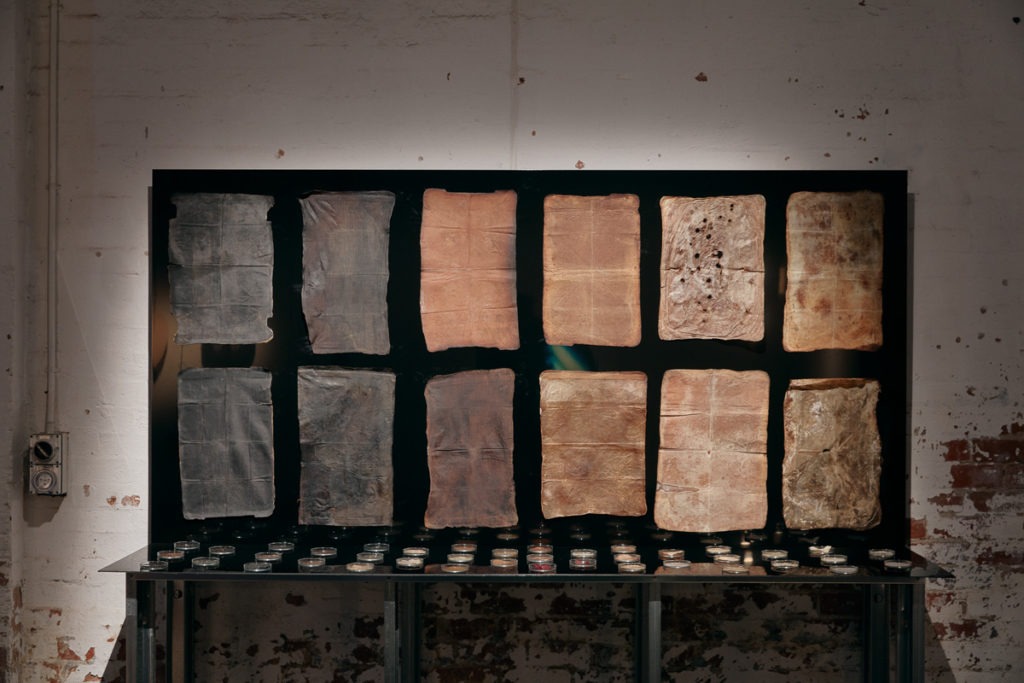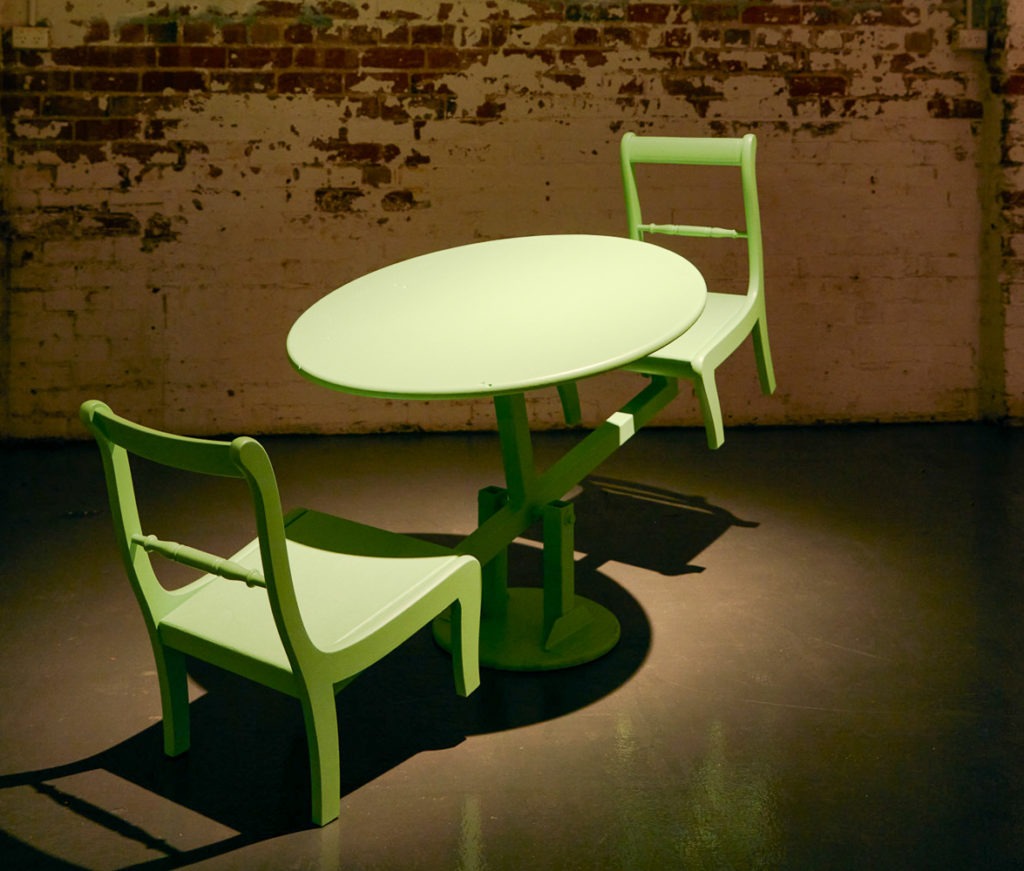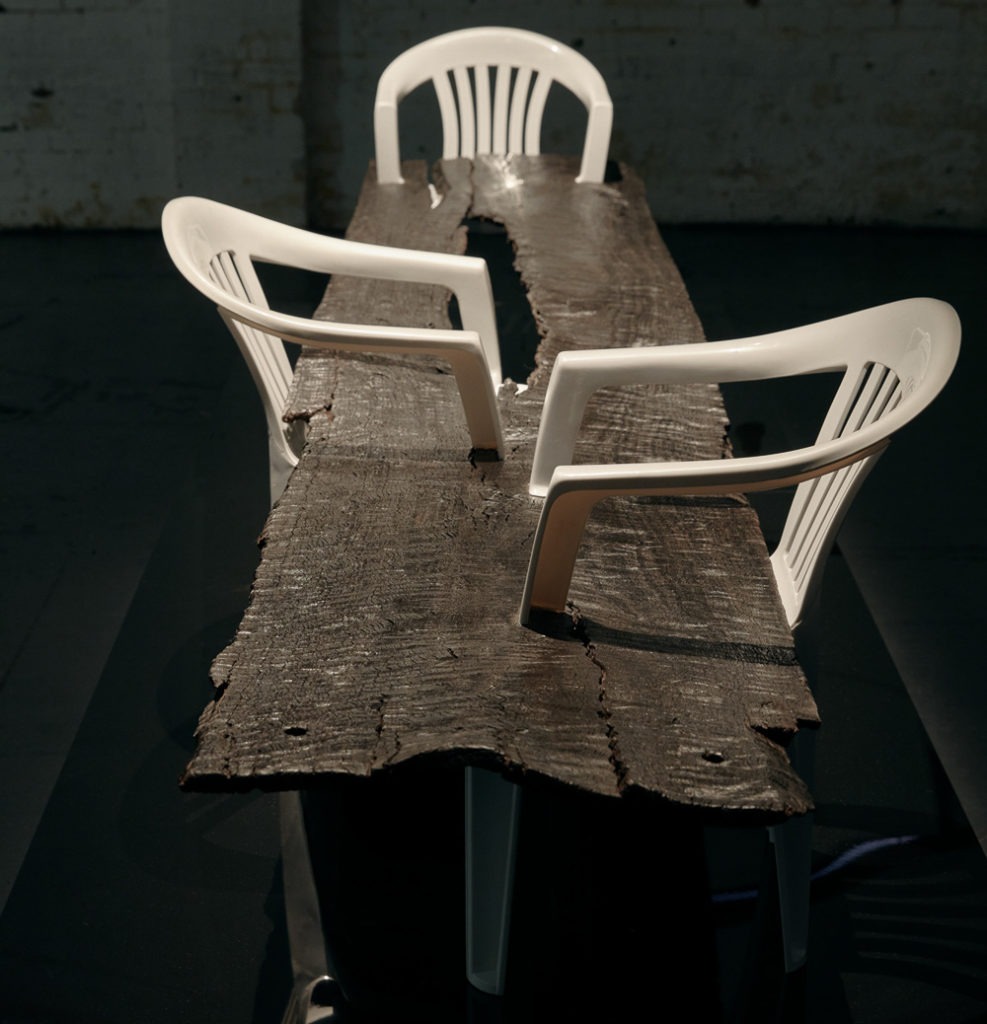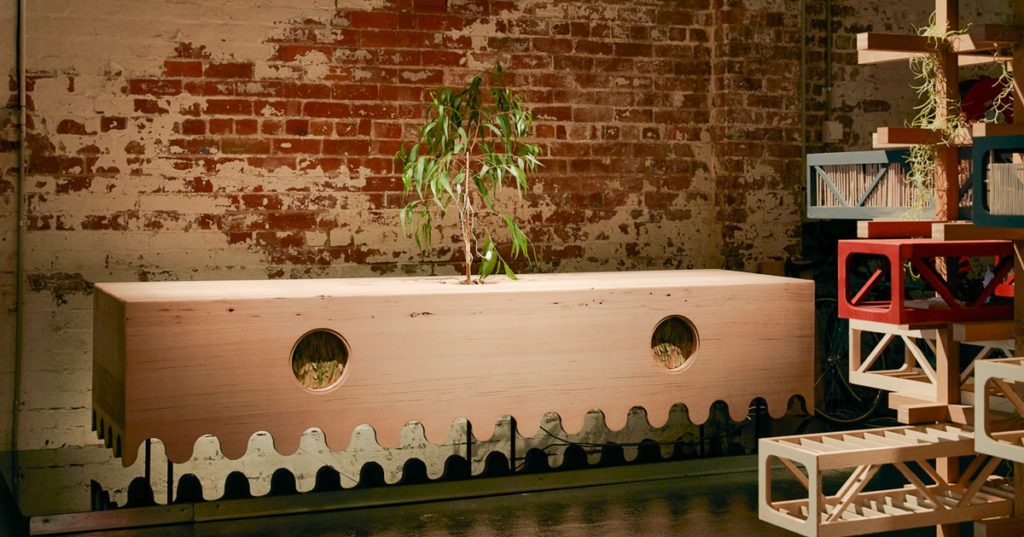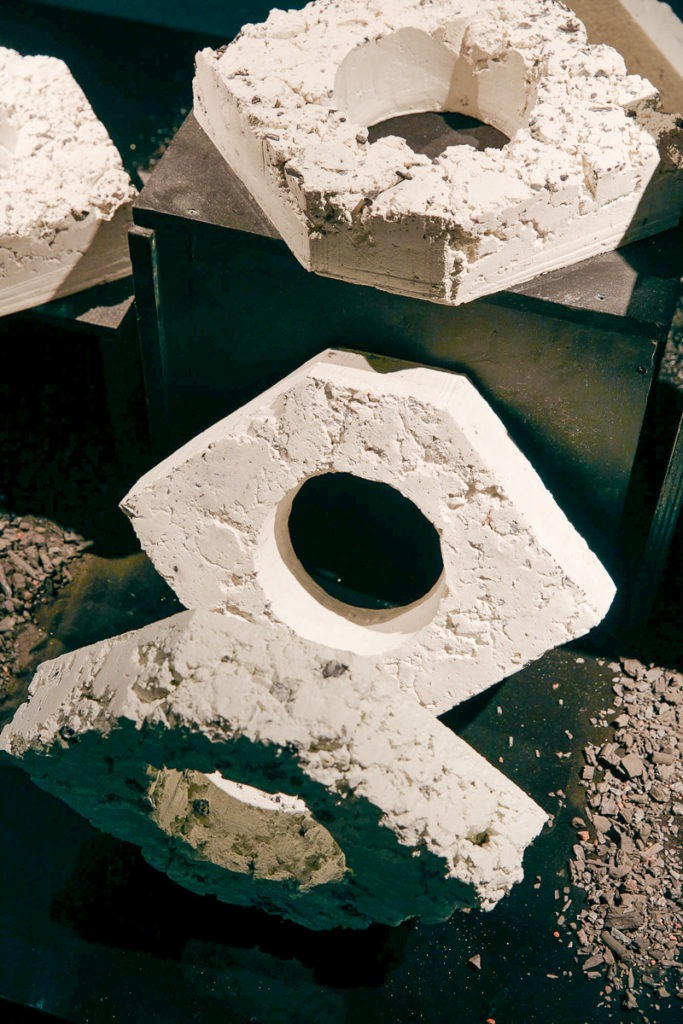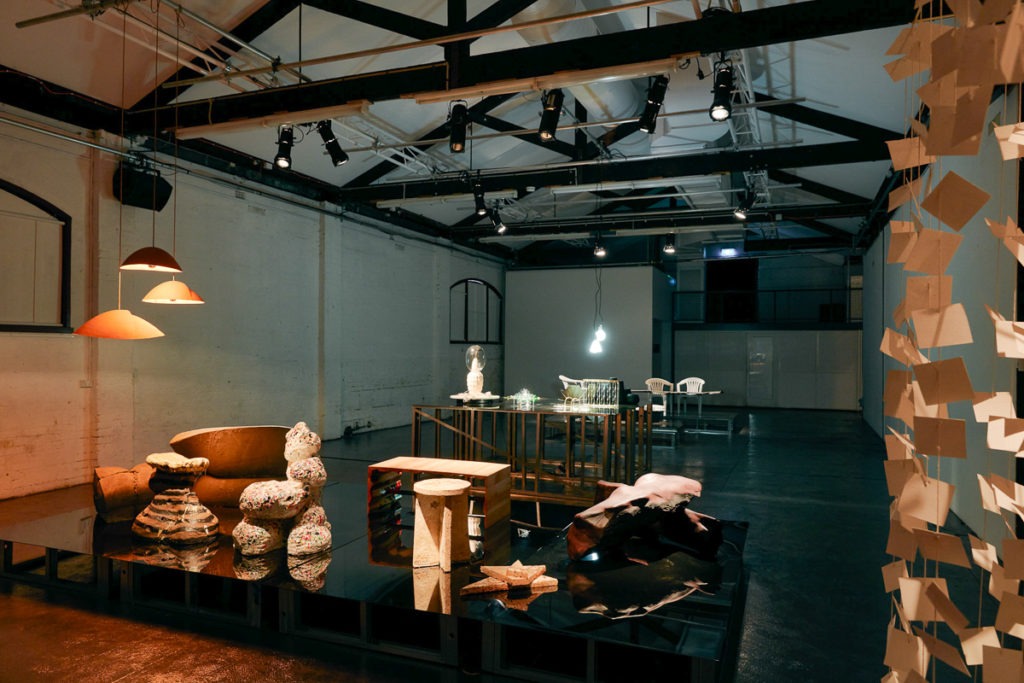
Life & Death is an exhibition curated by Dale Hardiman and Tom Skeehan which invites creative practitioners to create work which takes into account its own decay. Designer and researcher Guy Keulemans questions why we cling to objects despite their inevitable ephemerality.
Guy Keulemans‘ introduction to Life & Death:
Why did the chicken cross the road?
To get to the “other side”.
The most conceptual retelling of the chicken joke I’ve heard doesn’t change the actual joke but draws attention to a poetic allusion. “The other side” is the other side of death, the afterlife. The chicken, in a refutation of its own instinct for survival, crosses the road to commit suicide by car.
Given the current state of the planet, environment, industrial agriculture and chicken farming, this isn’t that surprising, though science assures me animals don’t willingly commit suicide in any human sense, even if bees die defending their colony, depressed dogs can starve themselves to death, and mice infected with the toxoplasmosis parasite lose their fear of cats.
It’s a human projection, placing our dank conceptions of life and death upon a hapless chicken protagonist. We do this all the time with designed objects too, narrativising their birth, life and death through stories of creation, use and waste. Materials have a soul, homewares have a heart and chairs have a life, often constrained to one family or a sequence of office rotations prior to retirement. Many objects find their lives trapped in the styles of the past, in the habitats of past decades or centuries and most people are happy to keep them there.
We make sense of the complex world of objects by giving objects a story, tapping into human instincts for family, community and personal relationships. This is the premise of sustainable design theories that asks designers to make products ‘emotionally durable’ or give them narratives that appeal and (hopefully) provide opportunities for love so they are not instantly consigned to the graveyard the moment they’ve lost their shine for life.
(Some of the lucky ones might even get a trip to the doctor! An operation at the object hospital, despite our ever-dwindling capacities for repair.)
But does the anthropomorphic narrativisation of products actually make sense? At the level of matter and physics, it’s kind of nonsense. Life is just a fleeting, exclusive property of some organic matter. A more dispassionate view can see objects just as chemicals and molecules in flux—a flow of protons and neutrons sustained in electrochemical structures that aren’t even that solid. This is a flow happening for billions of years since the Big Bang. A broken chip of plastic from an old vinyl chair—birthed from matter made in the supernova of a star!
I’ve got a box filled with e-waste. Old phones, cables, modems and computer junk. I once threw it out on a table in class and exhorted my students to “take a look at the world we’ve created!” (well, not the world they’ve created, but the one of waste created by their boomer and gen X parents). I really should get that shit recycled. Somehow I don’t. Beyond some minor hangups about data privacy, it feels like a keepsake of a perverse material wealth. Its dark narrative features child miners in east Africa, sleepless fingers twisting screws in Asia, and dock workers unloading load after load from fossil fuel-powered cargo ships. A global life. I suspect I value that copper, yttrium and other rare stuff in the e-waste more than the recyclers do.
Which suggests that the material of an object has a value above its market value, but also, I think, above and beyond whatever form it occupies. This may be anathema to designers trained and qualified to give form to matter. We stage these formal tricks as the main show. But in the journey of our planet, all our stuff can transform endlessly, rocks become metals that rust back into rocks. We need to pay more attention to this material flow to better understand the life and death of products and their impact in the world.
Perhaps it’s a question of understanding objects more as an atheist would, and less like the devout. The secular conception of death is essentially one of evaluating biochemical processes. The chicken’s corpse decays in the ground and provides food for worms and bacteria. But drowned and forgotten in a water tank, a dead chicken can harm. Likewise, our objects transform and change, in both good and bad ways that need scrutiny.
It is not just an issue of recycling. Recycling has a place, but knowing a material should also mean knowing the energies required to transform that material, and a lot of our recycling is wasteful. My local council in Sydney boasts about crushing glass bottles into asphalt for roads. They claim they are a sustainability leader, but apparently haven’t heard you can wash, sterilise and reuse glass bottles.
Maybe our feelings of love and attachment for objects get in the way of reducing consumption and waste… If we could be less passionate, we might be happier with less and feel less threatened about sharing it or seeing it transform into something else.
Life & Death curator Dale Hardiman sent me a neat example of how this doesn’t happen well in the world of high-end design: Harry Nuriev’s clear plastic sofa filled with fashion house Balenciaga discards. I don’t think I’ve ever seen a more acute symptom of wealthy people wanting to own clothes they don’t need and can’t wear – it’s so acute they store it in furniture. On the plus side, it’s a jackpot for the starving marauders of the future to find, once they’ve satiated themselves on the bodies of their Balenciaga-loving hosts.

Death isn’t the end of life anyway is it? The ‘other side’ is a place we can go. We can go there in our minds and imagine all sorts of afterlives and reincarnated creations for our departed devices, expired appliances and fallen furniture. The role of the 21st-century designer is now to create all sorts of wonderful creative worlds for products with expanded lives: afterlives, beforelives and currentlives.
Guy Keulemans is a designer and researcher at UNSW Sydney and represented by Gallery Sally Dan-Cuthbert.
Here are some of the works from the exhibition:
Alexi Freeman: BioTextiles
BioTextiles is a regenerative design project cultivated from anthropocentric waste currently destined for landfill. Once nutrient rich resources have been recovered they are used as feedstock for the cultivation of cellulose forming bacteria via a fermentation process. Within a month, the microorganisms secrete extracellular, nanofibrillar matrices which become textiles.
Life began with a single-celled organism 4 billion years ago. Humans have now evolved to contain an estimated 37.2 trillion living cells in one human body, each necessary for life!
When textiles are created for the design industry, trillions upon trillions of living cells are extracted from nature, made inert and compositised with other cells to build compound materials. This cycle perpetuates compression of the lithosphere, pollutes our hydrosphere with pesticides and litters our atmosphere with greenhouse gases. This myriad of ecological toxicities is contributing to the significant environmental challenges humanity faces today.
The textile industry is considered to be the second-largest ecological polluter globally, but there is a nascent field of research, led by companies such as Modern Meadow and Ecovative, that are seeking to transition design materials away from eco-toxic extraction, to that of a living biofabrication system.
With 7.7 billion humans rapidly consuming the only known planet to support life, the lens through which we view death urgently needs to be reframed.
Not only are we redesigning life itself, we are also redesigning death. Energy-intensive burials and cremation, which imprison or incinerate the nutrients of our bodies, are being substituted with natural burials, alkaline hydrolysis and composting. Resomation and Recompose are two companies exploring methods to regenerate the nutrients from our bodies more efficiently. Similarly, developing nascent systems to regenerate textiles is increasingly as vital as making ethical decisions about what we metabolise, wear and surround ourselves with in the first place.
BioTextiles proposes a method for regenerating design materials at end of life. Biological and technological waste can be recovered and transformed to return discarded nutrients to the material cycle. They can then be utilised as feedstock for the cultivation of a new colony of cellulose forming bacteria, shifting textiles towards a circular economy.
Breathe Architecture: Dining Table/ Seesaw
This piece ponders joyful social interaction as a characteristic that distinguishes life from death for humans. It represents this reflection in a dining scenario set on a see-saw — a playful scene that can only recognisably come alive with at least two people in balance.
This piece reflects on the theme of life from the human perspective and proposes that social interaction and joy are integral to life for humans, both as prerequisites for basic survival and as substance that provides meaning. It draws attention to the necessity of joyfully cooperating with others to achieve a common goal through the object by inviting participants into a dining scenario set on a see-saw — a scene that can only be recognisably used with two people in balance. The familiarity of both the dining table as a symbol of social interaction and the see-saw as a symbol of play strongly suggest how the object might be used, but leaves open how individuals engage, aiming to evoke this reflection whether viewed from a distance, bounced on, balanced on, sat on alone or with another.
This piece ponders the death of an object as being when it ceases to be useful to humans, both socially and functionally. It presents viewers with a dining scenario set on a see-saw which sits on an unusable angle when unengaged. In this mode, the dining table object is ‘dead’ in both forms, only brought to life once balanced by two people sitting on either side, giving it practical function and social purpose.
It takes this consideration into its materiality, formed of ‘dead’ furniture coloured uniformly, individually recognisable in shape but each a coherent part of a new object that re-instils the original purpose of its components, combined to elicit a reflection on the theme of life in humans through play and social interaction.
Damien Wright 5:45 18/02/2020
This piece was born at 5:45pm 18/02/2020 its date and time of death is unknown. Three Polypropylene plastic chairs intersect 10,000-year-old Ancient Redgum. The future both holding and consuming the past. A past that we disrespect and deny, a future we imagine as terror. Craft and design, life and death, now and then, ‘and so it goes’.
We are given life. We don’t ask for it. Yet we can make and we can take it. It is ours to look after to cherish or to ruin. My own life has hung by a thread more than once. I have seen that light. I have watched over my own body as it was plumbed back into action. I was gone but I was still alive. This work is about the incongruous nature of the now. That the past and the present are not binary. That our past is alive and its talking to and about our future. You can’t kill it. It knows you better than you know yourself.
Death. Dying is hard. Killing is hard and misunderstood. We need death to live, but we have such little knowledge and respect for those of us who deal with death. I can not write of death without thinking of my Aunt, my God Mother Sister Philomene Tiernan rscj. She was shot down in the MH17. As a nun who travelled a lot, aunty Phil would tell stories of rough flights where people would turn to her in fear for comfort, that somehow her religious life was a comfort in the face of death. I think of her as the plane descends holding someone’s hand and offering life.
Jesse Bennett Studio, Kristoffer Paulsen and Adam Lynch: static/dynamic
What if a tree could sing? What if it already does, we just don’t listen? static/dynamic is a meditation on this question. A Eucalypt sapling is placed in a large cabinet made from recycled Victorian Ash (also a Eucalypt), where electrodes are attached to its leaves which sense its internal biorythyms and convert them to MIDI data. The MIDI data is then sent to a synthesizer which plays through built in speakers. The piece can operate either in installation mode, where the MIDI data plays over long periods, interacting with its environment, or performance mode, where performers can bring their own equipment to interpret the MIDI data in real time incorporating it into their set.
The living sapling planted in the piece provides a dynamic, living element; reminding the viewer of what our furniture looks like before it becomes our furniture. Attached to the leaves of the sapling are electrodes which convert the internal biorhythms into electronic MIDI data, which when fed into a synthesizer become sound; constantly changing and responding to environmental stimuli such as temperature, moisture, airflow, light, human touch. We are accustomed to plants showing signs of response over time, but generally never with this kind of immediacy. The aim is to show how the sapling is a dynamic, living object.
Trees are the lungs of our planet, but also the roofs over our heads, and the beds on which we sleep. Trees are some of the most devastatingly beautiful lifeforms on this planet, yet also can become even more beautiful in death when harvested and turned into functional objects. What if the tree, instead of being turned into a cabinet to hold our enternainment devices became the entertainment itself? What would a tree tell us, if it could? Would a tree hear the sound and respond? What would the data tell us if captured over long periods of time? Is the timber really dead? Or does it simply transition through different states of being? In its new form, the energy and life force in the mass of felled log does not cease to bring vibrancy and warmth into the world, even through death it still bears life as it floats in its environment.
Dr Areli Avendano Franco, Dr Judith Glover, Dr Liam Fennessy, Dr Simon Lock- rey, Assoc. Prof. Everson Kandare, Miss Jaclyn Pokrovsky, Michael Flood, Tammay Bhat and Dr Merhnoush Latifi: Fireless Skin: Mycelium Biocomposites
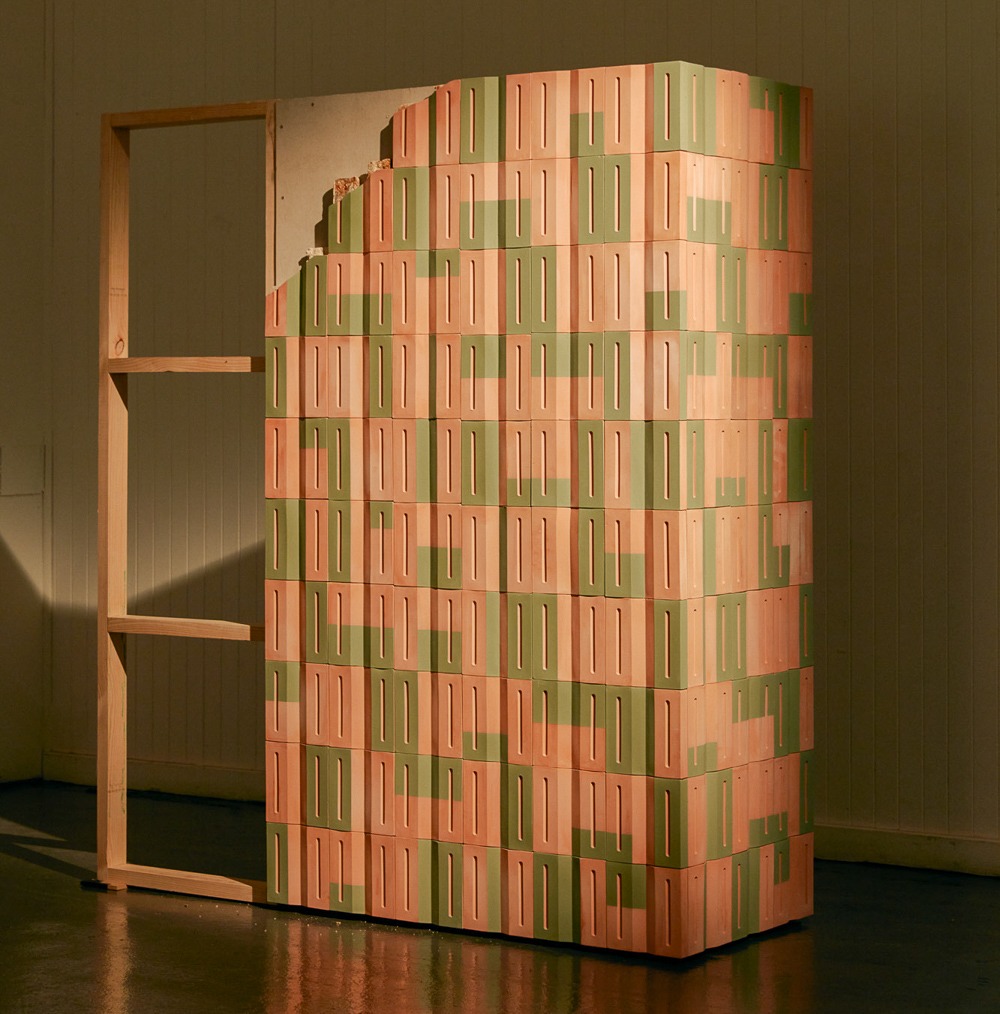
Dr Areli Avendano Franco, Dr Judith Glover, Dr Liam Fennessy, Dr Simon Lockrey, Assoc. Prof. Everson Kandare, Miss Jaclyn Pokrovsky, Michael Flood, Tammay Bhat and Dr Merhnoush Latifi
Fireless Skin: Mycelium Biocomposites
Fireless Skin is a non-flammable building skin utilising the Mycelium bio-composite into hollow ceramic tiles adding extra insulative properties. The tiles allow for customisable decorative surfacing options in both 3d surface treatment and glazing options through combinations of digital and traditional technologies.
Fireless Skin is an organic product that is developed through merging a living fungus with glass fines, i.e. small particle residues from the glass recycling process. A fungus was trained to integrate the glass fines into its own body. The resulting material has unique fire-resistant properties: the Heat Release Rate of materials is the driving force of fires once they have started and it is here where Fireless Skin excels. It releases around a quarter of the heat compared to commercially available products such as extruded polystyrene (XPS) or particle board. Ultimately, the death of a product and its absorption by a fungi, a living thing, creates something new that will protect the life of the building occupants it will hold within.
At the end of its useful life, a product is separated in its parts: some parts may find immediate new uses, others may be left behind to ‘die’. Glass fines are a by-product that is left behind from the glass recycling process at a rate of 62,000 tonnes per year in Victoria. Fireless Skin is developed by letting glass fines die a second and a third death. The glass fines are contaminated with 30% of organic waste from product labels, residual sugars and yeast. A fungus, Mycellin, has been trained to feed on the glass fines and its contamination in order to transform and integrate it into its biological matrix. This biomass proved to have unique properties relevant to fire safety materials and it is proposed to farm the material and transform it in safer and more fire-resistant building products that replace commercially available synthetic polymers and particle boards.
Studio Edwards: The Phoenix Will Rise from the Ashes
Individually numbered stacked bricks made from ash & clay. Ash collected from bushfire destroyed areas of Victoria. Clay dug from a number of Bush fire affected sites.
Each brick begins to give physical form and shape a new future.
A foundation upon which to build. An opportunity to make and re-imagine.
A materiality derived from a changed and impacted landscape.
Each brick a memorial to remind of our fragility. A memory that we must address.
Each brick bears witness to its history.
Remembering its previous life. Its previous materiality as a fuel for oxidisation.
Burnt.
The forces of combustion transform what was refuge, habitat & home to become ash.
Leftover carbon – too heavy to become airborne.
Life & Death was organised by Dale Hardiman and Tom Skeehan as Friends & Associates (March 2020). The exhibition was at the Meat Market as part of Melbourne Design Week before the coronavirus cut it short.

